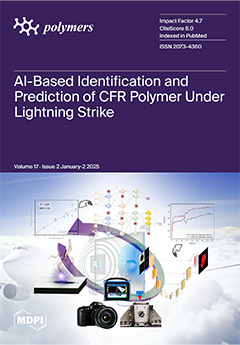Our work describes the green synthesis of silver sulfide nanoparticles (Ag
2S NPs) and their formulation into polycaprolactone fibers (PCL), aiming to improve the multifunctional biological performance of PCL membranes as scaffolds. For this purpose, an extract of rosemary (
Salvia rosmarinus
[...] Read more.
Our work describes the green synthesis of silver sulfide nanoparticles (Ag
2S NPs) and their formulation into polycaprolactone fibers (PCL), aiming to improve the multifunctional biological performance of PCL membranes as scaffolds. For this purpose, an extract of rosemary (
Salvia rosmarinus) was employed as a reducing agent for the Ag
2S NPs, obtaining irregular NPs and clusters of 5–60 nm, with a characteristic SPR absorption at 369 nm. Ag
2S was successfully incorporated into PCL fibers by electrospinning using heparin (HEP) as a stabilizer/biocompatibility agent, obtaining nanostructured fibers with a ca. 500–800 nm diameter. Different amounts of Ag
2S NPs (0.05, 0.5, and 1 wt.%) enhanced the nanostructured membranes’ surface polarity and mechanical performance, with a controlled ion release after 6 days submerged in PBS solution, determined by cyclic voltammetry. As a result, PCL/HEP/Ag
2S scaffolds exhibit high antibacterial performance (80–90%) at early stages of contact (3 h) against
E. coli and
S. aureus. Also, cytotoxicity analysis demonstrated that the nanostructured membranes are biocompatible and exhibit high fibroblast cell regeneration, which is optimal for their application as scaffolds. To validate the regenerative response of PCL/HEP/Ag
2S scaffolds, controlled wounds were induced in Wistar rats, presenting a favorable healing response by contact with PCL/HEP/Ag
2S 1%, compared with the untreated wound. Our results indicated that nanostructured scaffolds enable the development of novel nanomaterials with multifunctional biological performance.
Full article






